
Selected projects
After a competitive assessment process, these 14 projects have not only been selected for their innovativeness but also for their transfer potential to other EU cities and their capacity in establishing solid local partnerships. The selection was announced during the the ‘New European Bauhaus in Regions and Cities’ event in Brussels.
Supported by a total ERDF budget of EUR 65 million, the selected urban authorities will have the opportunity to experiment creative, innovative and sustainable solutions and to serve as a new generation of New European Bahaus demonstrators under cohesion policy in the areas of:
- constructing and renovating in a spirit of circularity and carbon neutrality,
- preserving, and transforming cultural heritage,
- adapting and transforming buildings for affordable housing solutions,
- regenerating urban spaces.
In the coming months, each selected project will have a dedicated webpage with information on their implementation as well as the main learning points captured by IA Experts.
Discover the 14 projects by clicking on the titles below.
ImperfectCity - Municipality of Aarhus
Aarhus Kommune
ERDF Budget: €4,998,952.32
The city of Aarhus aims at increasing public awareness for the perpetual imperfection of our cities. Aarhus ran into several “wicked” problems (WiP) by trying to build a perfect welfare state, such as the deteriorating mental health of youth and brutalist buildings. To tackle these challenges, ImperfectCity is a re-thinking neighbourhood-planning method created by and built for its citizens. The solution is based on changing the mindset and reducing the stigma of both Brutalist buildings and mental health patients by applying heritage innovation, environmental innovation and social innovation, using New European Bauhaus principles. With Lego Serious Play methodology, an innovative combination for urban planning and building self-inclusion, ImperfectCity will develop an inclusive future, sustainable and beautiful for the eyes, mind and soul.
Partnership: Municipality of Aarhus; 3 NGOs: Skejby Rangers, SIND Aarhus-Samsø, Museum Ovartaci ; 3 Education/training centres and schools: FO-Aarhus (Free Education Association), The Day Highschool Gimle, FGU Aarhus; 2 Others: The Foundation Ryesgade 7, House Owners' Association at Olof Palmes Alle 11; 1 Entreprise: Ramboll Denmark; 1 Business support organisation: Erhverv Aarhus; 1 Higher education and research organisation: Aarhus School of Architecture; 3 transfer cities – to be selected
AHA Budapest – Municipality of Budapest
Budapest Főváros Önkormányzata
ERDF budget: €4,985,110.40
The AHA Budapest project aims to address housing insecurity and energy poverty with new flexible and affordable solutions. The project aims to develop an Integrated Housing Service Model with a set of offers for permanent and temporary housing relying on both the public and private housing stocks. An early warning system will be set up to anticipate social and energy interventions for new at-risk target groups. A smart support scheme will be developed to promote safe temporary cohabitation and flat exchange arrangements based on engagement, trust building, mentoring and mediation. A revolving fund for energy efficient retrofit grants and other flexible interventions will be tested to reduce energy poverty and prevent the degradation of dwellings. An unused non-residential public building will be renovated and repurposed for near-zero energy social housing using energy efficient technologies and low-cost, aesthetic modular interior by inclusive design approaches involving beneficiaries.
Partnership: Budapest Municipality; 1 sectoral agency: Budapest Brand Nonprofit Plc.; 4 SME: NART Architects Studio Llc., Popcode Developments Ltd., Metropolitan Research Institute, BURST (Bright Urban Solution Team) Nonprofit LLC.; 3 NGOs: From Streets to Homes! Association, Hungarian Contemporary Architecture Centre Foundation, Energiaklub Association.
RELAUNCHTOWIN – Municipality of Burgas
Община Бургас
ERDF budget: €4,507,472.00
The City of Burgas aims to create an aesthetic, functional and sustainable urban environment which inspires creativity, collaboration, and life-long learning. RELAUNCHTOWIN will renovate a Sports Hall with energy efficiency measures and transform the surrounding areas with nature-based solutions to combat climate change. The Municipality of Burgas aims at adding new functions to the site including creating a community centre for social collaboration and the sustainability of local culture and traditions. RELAUNCHTOWIN will lead to better physical and mental health of local people and give citizens a stronger sense of belonging whilst improving their knowledge of energy efficiency and climate adaption measures.
Partnership: Burgas Municipality; 4 SME: Molt Design Group EOOD, Centar play EOOD, Prikazno carstvo EOOD, Biotiful; 1 Higher education and research organisations: Assen Zlatarov University; 1 NGOs: BG Be Active; 3 transfer cities – to be selected
Rock the Block - Municipality of Egaleo
Δήμος Αιγάλεω
ERDF budget: €3,280,920.00
The City of Egaleo seeks to tackle the vicious cycle created between low housing quality/unsatisfied housing needs and weak community bonds. To reach this goal, the Rock the Block project proposes an innovative Urban Policy and Funding tool to improve housing via technical transformations and renovations. Residents will also benefit via community building and upskilling and institutional interventions for care and support. Following New European Bauhaus principles, the innovative project uses “Polykatoikia” as the intervention unit to deal collectively with common problems, setting up a new transferable urban policy and funding tool and two new municipal structures.
Partnership: Municipality of Egaleo (MoE); 2 SME: Symbolo GP, AREA (Architecture Research Athens); 3 Higher education and research organisations: National Centre of Scientific Research (NCSR) "Demokritos", Aristotle University of Thessaloniki, Regional Development Institute – Panteion University (RDI); 4 NGOs: Urbana, InCommON (Innovative Communities Onwards), Organization Earth, Ohi Pezoume Performing Arts NPO (OP); 3 transfer cities – to be selected
SHARE - Municipality of Fuenlabrada
Ayuntamiento de Fuenlabrada
ERDF budget: €4,920,000.00
Revitalizing the center of Fuenlabrada is crucial for addressing the city's main challenges, including deteriorated housing quality, high vacancy rates for both residential and commercial spaces and an aging population that exceeds the city's average. The main concept of the SHARE project is to propose a new housing model based on intergenerational solidarity, aligning with the principles of the new European Bauhaus. The project involves renovating a former school to establish a Lifelong Housing Center for elderly people residing in the city center, while their previous apartments are transformed into social housing for young individuals. This innovative model seeks to preserve the autonomy of the elderly while providing stability for the younger generation, ultimately enhancing the downtown area by creating accessible, affordable and high-quality living environments for both seniors and youth. To support this innovative vision, a City Centre Community Care Unit (4CU) will be established, facilitating collaboration among municipal authorities, key partners, and stakeholders.
Partnership: Municipality of Fuenlabrada; 4 SME: Municipal Housing Institute of Fuenlabrada PLC (IMVF), Fuenlabrada Communication Media PLC (FUMECO), Animajoven PLC, Khora Urban Thinkers; 1 Other: Matia Instituto Foundation; 1 Higher education and research organisation: National University of Distance Education; 1 NGOs: Coexistence Board; 3 transfer cities – to be selected
Time2Adapt - Lille European Metropolis
Métropole Européenne de Lille
ERDF budget: €4,993,749.76
The temperature has increased by 2°C between 1955 and 2017 in the metropolitan area of Lille, questioning the liveability of urban areas especially in summer, causing discomfort and inequalities. The Metropole of Lille seeks to adapt to climate change and regenerate urban spaces by intensifying the way we use them to have more places adapted to become thermal shelters. Time2Adapt project will put in place a co-development process to make the city more liveable, more attractive, in a more egalitarian and socially just place, following New European Bauhaus principles. The idea is to test at metropolitan scale a time-based urbanism as a lever for better use of public buildings and spaces, thereby answering the need for more cool places in warm periods in cities, while limiting land artificialisation, building on the existing urban fabric. To reach this objective, innovative solutions will consist in adapting opening schedules of cool places, creating new uses and transforming other places to make them cooler and opening them to all, as well as temporary occupying public spaces with refreshing artistic installations, with a focus on encouraging appropriation and innovative methods of managing these places.
Partnership: Lille European Metropolis; 2 Local public authorities: City of Lille, City of Loos; 1 National public authority: Cerema; 1 NGOs: SEED; 1 Other: Group A - Cultural Cooperative; 1 SME: Sociotopie; 1 Regional Public authority: Hauts de France Regional Agency for Working Conditions Improvement; 3 transfer cities – to be selected
NatUR-W – Municipality of Lorca
Ayuntamiento de Lorca
ERDF budget: €4,779,752.00
NatUR-W (Nature-based Urban Regeneration through Water) project aims at regenerating the urban area of the city of Lorca, to face energy poverty and the inefficient use of natural water resources caused by climate change. The city will implement innovative, inclusive, sustainable and self-sufficient nature-based solutions that integrate the natural water cycle of the area to improve the energy efficiency of social housing and public buildings, rehabilitating an old prison into a citizen's university. These solutions will improve the living conditions of the dwellings and create new green areas that can act as bioclimatic shelters and provide Ecosystems Services, using New European Bauhaus principles.
Partnership: Lorca City Council; 3 SME: SingularGreen, INDRESMAT, NBSCLIMATE; 1 Higher education and research organisation: Aristotle University of Thessaloniki, UNESCO Center on Integrated and Multidisciplinary Water Resource; 3 transfer cities – to be selected
WATSUPS - Municipality of Mechelen
Mechelen
ERDF budget: €4,799,328.00
WATSUPS project aims at mitigating the risk of gentrification by developing a new public space alongside the river Dyle in the city of Mechelen. A visible blue-green corridor will connect people, water and nature. The city chooses to preserve water in the urban landscape, assuring access to all citizens rather than privatizing urban water. They will establish a permanent outdoor swimming area, create river terraces and lowered riverbanks around the Dyle, connect the fragmented walking and cycling zones and develop brand new public parks and park lanes for recreation and social cohesion. The multi-species approach will be strengthened by augmented and virtual reality. Using New European Bahaus principles, the innovative solution will raise awareness on water ecosystems and biodiversity and will strengthen the ecosystem by new technologies and nature-based solutions.
Partnership: City of Mechelen; 2 Infrastructure and (public) service providers: Flemish Water Ways, Flemish Environmental Society; 1 Higher education and research organisation: Thomas More University of Applied Sciences; 1 NGOs: Mechelen Cultural Events ngo; 3 transfer cities – to be selected
We-Z - District III of Rome – Montesacro
Municipio Roma 3 - Montesacro (MUA)
ERDF budget: €4,980,342.40
We-Z tests a transitional model of urban regeneration to improve mental health in young people. The experimental site is a ‘70s public housing complex called Vigne Nuove located in the North-Eastern periphery of Rome, remained largely unfinished, and today characterised by a diffuse sense of neglect and isolation. The We-Z project will experiment an innovative de-medicalized approach to urban regeneration through the activation of collective imaginations and co-creation activities. We-Z will re-activate affective bonds between people and places and build an attractive district, based on transitional spaces and objects to trigger the active and self-reflective engagement of young people.
Partnership: District III of Rome – Montesacro; 1 Higher education and research organisation: Department of Architecture, Roma Tre University; 3 Sectoral agencies: LOCAL HEALTHCARE ENTERPRISE ROMA1, ATER - Agenzia Territoriale Edilizia Residenziale, Soprintendenza Speciale Archeologia Belle Arti e Paesaggio di Roma (SSABAP); 4 SME: Officine Zero, Future Ecologies, Avanzi. Sostenibilità per Azioni S.p.A. SB, Solidarius Italy s.e.; 2 Others: Parsec Agri Cultura company Agricultural social cooperative, PARSEC SOCIAL COOPERATIVE; 1 NGOs: Artestudio; 3 transfer cities – to be selected
S4T - Municipality of Rovereto (COR)
Comune di Rovereto
ERDF budget: €4,997,697.50
The alpine town of Rovereto needs to improve the quality of life of its citizens by regenerating and transforming the cultural heritage of the territory in face of mounting climate and biodiversity challenges. Therefore, the city proposes to transform the empty main building of the train station and its surrounding area into a public-civic hub whose spaces will serve as interactive venues for training, co-design, co-production and knowledge transfer for promising public, civic and economic initiatives on to tackle climate change, biodiversity loss and heritage regeneration. The implementation of the S4T solution mobilizes NEB’s three core values and principles of “Understand, Adapt and Use”.
Partnership: Municipality of Rovereto (COR); 1 local public authority: Community of the Lagarina valley (LAG); 3 NGOs: La Foresta- Community academy (FOR), Europe Consulting (EUC), International Cooperation Centre (CCI); 2 Higher education and research organisations: University of Trento (UTN), COFAC - Cooperativa de Formação e Animação Cultural C.R.L. (COF); 2 SME: Campomarzio social cooperative (CAM), Trentino Social Tank cooperative society (TST); 3 transfer cities – to be selected
SOFTacademy – Municipality of Tallinn
Tallinna linn
ERDF budget: €4,999,248.00
The SOFTacademy project seeks to accelerate neighbourhood level circular renovation of large multi-owner apartment buildings with a hardware and software approach demonstrating how residents’ initiatives in renovation boosts re-design of the whole neighbourhood, including spaces in between buildings. The project will develop a collaborative innovation model for urban governments to accelerate private renovation by improving overall urban liveability, creating better micro-climate, increasing biodiversity, accommodating community functions, changing the scale of buildings and creating “cozier” and more human scale living environment. The intervention logic as well as digital tools developed as a part of the solution are transferable to any mass-produced mono-functional apartment building districts that needs a change that goes beyond just renovation and is able to give a sense of place and identity.
Partnership: Tallinn city; 1 Higher education and research organisation: Tallinn University of Technology; 6 NGOs: M TÜ Living Street, Estonian Union of Co-operative Housing Associations, Housing Assosiation Akadeemia tee 4, Housing Association Akadeemia tee 6, Housing Assosiation Akadeemia tee 14, Housing Assosiation Akadeemia tee 22; 3 SME: Yoko Oma OÜ, LAB Verte, Think Softer Planning AB.
Urban Biodiversity Parks – Municipality of Turku
Turun kaupunki
ERDF budget: €3,898,963.36
The city of Turku has an ambition to become one of the world’s leading nature and climate cities. Therefore, Turku Biodiversity Action Plan seeks to protect and restore biodiversity in urban areas where habitats are lost due to rapid urbanization, through innovative solutions. Following New European Bahaus principles, Urban Biodiversity Parks project will develop an innovative concept of urban biodiversity park as a tool to establish a platform for developing and testing experimental approaches, for preserving and actively enhancing biodiversity in urban environment. This project will involve different groups such as local inhabitants, NGOs, education institutions and private actors, to increase stakeholders’ awareness and capacity for biodiversity conservation.
Partnership: City of Turku; 3 Higher education and research organisations: University of Turku, Turku University of Applied Sciences Ltd, Natural Resources Institute Finland; 1 Regional Public Authority: Valonia Regional Council of Southwest Finland; 1 NGOs: Wild Zone; 1 Enterprise: Vaso Ltd; 1 SME: Blokgarden Oy; 3 transfer cities – to be selected
InterAct Green - Municipality of Varaždin
Grad Varaždin
ERDF budget: €4,133,140.48
The Agglomeration of Varaždin and Ludberg, located in the north Croatia, have a high strategic interest: the River Drava Forest Park. However, this Drava Park faces three main challenges: management difficulties, unused public spaces and forest degradation. Therefore, the InterAct Green project aims to create a Green Infrastructure Platform that will serve to answer the interdisciplinary management issues, to ensure a proper functioning of it while securing usable information for visitors to the park. This platform will serve as a tool in decision making and communication between all stakeholders. By doing so, the proposed physical infrastructure investments together with the long-term forest regeneration plan for the ecosystem in the area will result in high quality, inclusive and safe-public space.
Partnership: The City of Varaždin; 1 local public authority: The City of Ludbreg (CL); 2 Higher education and research organisations: Faculty of Organization and Informatics, University of Zagreb (FOI), Croatian Forest Research Institute (CFRI); 1 Regional public authority: Public institution 'Nature of Varaždin County' (PINVC); 1 sectoral agency: Varaždin Tourist board (VTB); 3 transfer cities – to be selected
Viana S+T+ARTS Centre-Municipality of Viana do Castelo
Município de Viana do Castelo
ERDF budget: €4,994,857.60
The Municipality of Viana de Castelo aims to increase city’s attractiveness towards young talents by triggering its blue innovation potential. The project will deliver a creative and community lab operating in the spirit of Science+Technology+ARTS and potentiating art-driven blue innovation, to co-create unconventional solutions and revitalise the surrounding poor neighbourhood. To host this Centre, the project will transform the municipal old slaughterhouse building, demonstrating a set of innovative energy-efficiency, low carbon and circular solutions and using New European Bauhaus principles. The retrofitted and amplified building will be a fusion of innovative components (including experimental technologies currently available in prototype version) that have never been brought together in one single establishment, which will be tested in a real environment. This includes the use of experimental practices involving natural local residues as construction materials, a novel system for storing surplus electrical renewable energy of the building in the form of green hydrogen and turning this back into electricity when there is deficit of production, as well as the first building to integrate a digitally controllable rotating pilot division to maximise solar energy harvest. Viana S+T+ARTS Centre project will provide novel sustainability solutions and contribute to environmentally responsible behaviour in the community.
Partnership: Viana do Castelo Municipality; 1 NGOs: Deão Youth Association; 1 Other: Institute for Research and Tech Development in Construction, Energy, Environment and Sustainability; 2 SME: INOVA+, INNOVATION SERVICES S.A., DINAMO10; 1 Business support organisation: Business Association of Viana do Castelo; 1 Higher education and research organisation: Polytechnic Institute of Viana do Castelo; 3 transfer cities – to be selected
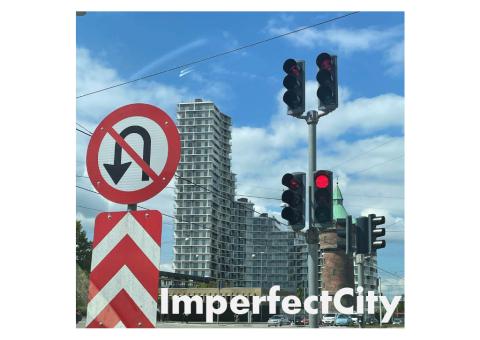 Aarhus visual
Aarhus visual
Aarhus Kommune
ERDF Budget: €4,998,952.32
The city of Aarhus aims at increasing public awareness for the perpetual imperfection of our cities. Aarhus ran into several “wicked” problems (WiP) by trying to build a perfect welfare state, such as the deteriorating mental health of youth and brutalist buildings. To tackle these challenges, ImperfectCity is a re-thinking neighbourhood-planning method created by and built for its citizens. The solution is based on changing the mindset and reducing the stigma of both Brutalist buildings and mental health patients by applying heritage innovation, environmental innovation and social innovation, using New European Bauhaus principles. With Lego Serious Play methodology, an innovative combination for urban planning and building self-inclusion, ImperfectCity will develop an inclusive future, sustainable and beautiful for the eyes, mind and soul.
Partnership: Municipality of Aarhus; 3 NGOs: Skejby Rangers, SIND Aarhus-Samsø, Museum Ovartaci ; 3 Education/training centres and schools: FO-Aarhus (Free Education Association), The Day Highschool Gimle, FGU Aarhus; 2 Others: The Foundation Ryesgade 7, House Owners' Association at Olof Palmes Alle 11; 1 Entreprise: Ramboll Denmark; 1 Business support organisation: Erhverv Aarhus; 1 Higher education and research organisation: Aarhus School of Architecture; 3 transfer cities – to be selected
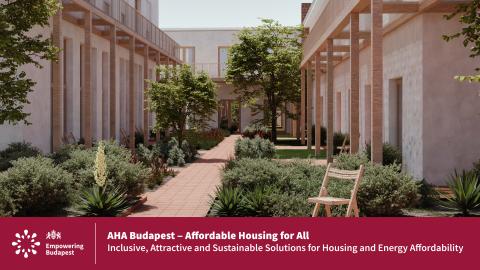 AHA Budapest visual
AHA Budapest visual
Budapest Főváros Önkormányzata
ERDF budget: €4,985,110.40
The AHA Budapest project aims to address housing insecurity and energy poverty with new flexible and affordable solutions. The project aims to develop an Integrated Housing Service Model with a set of offers for permanent and temporary housing relying on both the public and private housing stocks. An early warning system will be set up to anticipate social and energy interventions for new at-risk target groups. A smart support scheme will be developed to promote safe temporary cohabitation and flat exchange arrangements based on engagement, trust building, mentoring and mediation. A revolving fund for energy efficient retrofit grants and other flexible interventions will be tested to reduce energy poverty and prevent the degradation of dwellings. An unused non-residential public building will be renovated and repurposed for near-zero energy social housing using energy efficient technologies and low-cost, aesthetic modular interior by inclusive design approaches involving beneficiaries.
Partnership: Budapest Municipality; 1 sectoral agency: Budapest Brand Nonprofit Plc.; 4 SME: NART Architects Studio Llc., Popcode Developments Ltd., Metropolitan Research Institute, BURST (Bright Urban Solution Team) Nonprofit LLC.; 3 NGOs: From Streets to Homes! Association, Hungarian Contemporary Architecture Centre Foundation, Energiaklub Association.
 Burgas
Burgas
Община Бургас
ERDF budget: €4,507,472.00
The City of Burgas aims to create an aesthetic, functional and sustainable urban environment which inspires creativity, collaboration, and life-long learning. RELAUNCHTOWIN will renovate a Sports Hall with energy efficiency measures and transform the surrounding areas with nature-based solutions to combat climate change. The Municipality of Burgas aims at adding new functions to the site including creating a community centre for social collaboration and the sustainability of local culture and traditions. RELAUNCHTOWIN will lead to better physical and mental health of local people and give citizens a stronger sense of belonging whilst improving their knowledge of energy efficiency and climate adaption measures.
Partnership: Burgas Municipality; 4 SME: Molt Design Group EOOD, Centar play EOOD, Prikazno carstvo EOOD, Biotiful; 1 Higher education and research organisations: Assen Zlatarov University; 1 NGOs: BG Be Active; 3 transfer cities – to be selected
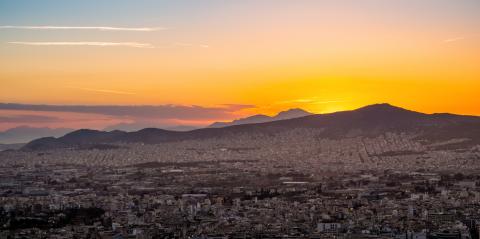 Rock the Block visual
Rock the Block visual
Δήμος Αιγάλεω
ERDF budget: €3,280,920.00
The City of Egaleo seeks to tackle the vicious cycle created between low housing quality/unsatisfied housing needs and weak community bonds. To reach this goal, the Rock the Block project proposes an innovative Urban Policy and Funding tool to improve housing via technical transformations and renovations. Residents will also benefit via community building and upskilling and institutional interventions for care and support. Following New European Bauhaus principles, the innovative project uses “Polykatoikia” as the intervention unit to deal collectively with common problems, setting up a new transferable urban policy and funding tool and two new municipal structures.
Partnership: Municipality of Egaleo (MoE); 2 SME: Symbolo GP, AREA (Architecture Research Athens); 3 Higher education and research organisations: National Centre of Scientific Research (NCSR) "Demokritos", Aristotle University of Thessaloniki, Regional Development Institute – Panteion University (RDI); 4 NGOs: Urbana, InCommON (Innovative Communities Onwards), Organization Earth, Ohi Pezoume Performing Arts NPO (OP); 3 transfer cities – to be selected
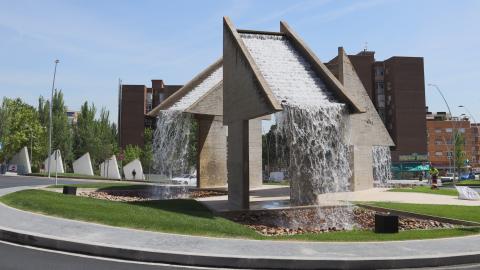 SHAR visual
SHAR visual
Ayuntamiento de Fuenlabrada
ERDF budget: €4,920,000.00
Revitalizing the center of Fuenlabrada is crucial for addressing the city's main challenges, including deteriorated housing quality, high vacancy rates for both residential and commercial spaces and an aging population that exceeds the city's average. The main concept of the SHARE project is to propose a new housing model based on intergenerational solidarity, aligning with the principles of the new European Bauhaus. The project involves renovating a former school to establish a Lifelong Housing Center for elderly people residing in the city center, while their previous apartments are transformed into social housing for young individuals. This innovative model seeks to preserve the autonomy of the elderly while providing stability for the younger generation, ultimately enhancing the downtown area by creating accessible, affordable and high-quality living environments for both seniors and youth. To support this innovative vision, a City Centre Community Care Unit (4CU) will be established, facilitating collaboration among municipal authorities, key partners, and stakeholders.
Partnership: Municipality of Fuenlabrada; 4 SME: Municipal Housing Institute of Fuenlabrada PLC (IMVF), Fuenlabrada Communication Media PLC (FUMECO), Animajoven PLC, Khora Urban Thinkers; 1 Other: Matia Instituto Foundation; 1 Higher education and research organisation: National University of Distance Education; 1 NGOs: Coexistence Board; 3 transfer cities – to be selected
Métropole Européenne de Lille
ERDF budget: €4,993,749.76
The temperature has increased by 2°C between 1955 and 2017 in the metropolitan area of Lille, questioning the liveability of urban areas especially in summer, causing discomfort and inequalities. The Metropole of Lille seeks to adapt to climate change and regenerate urban spaces by intensifying the way we use them to have more places adapted to become thermal shelters. Time2Adapt project will put in place a co-development process to make the city more liveable, more attractive, in a more egalitarian and socially just place, following New European Bauhaus principles. The idea is to test at metropolitan scale a time-based urbanism as a lever for better use of public buildings and spaces, thereby answering the need for more cool places in warm periods in cities, while limiting land artificialisation, building on the existing urban fabric. To reach this objective, innovative solutions will consist in adapting opening schedules of cool places, creating new uses and transforming other places to make them cooler and opening them to all, as well as temporary occupying public spaces with refreshing artistic installations, with a focus on encouraging appropriation and innovative methods of managing these places.
Partnership: Lille European Metropolis; 2 Local public authorities: City of Lille, City of Loos; 1 National public authority: Cerema; 1 NGOs: SEED; 1 Other: Group A - Cultural Cooperative; 1 SME: Sociotopie; 1 Regional Public authority: Hauts de France Regional Agency for Working Conditions Improvement; 3 transfer cities – to be selected
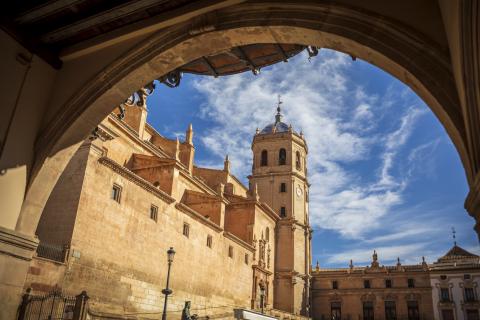 NatUR-W visual
NatUR-W visual
Ayuntamiento de Lorca
ERDF budget: €4,779,752.00
NatUR-W (Nature-based Urban Regeneration through Water) project aims at regenerating the urban area of the city of Lorca, to face energy poverty and the inefficient use of natural water resources caused by climate change. The city will implement innovative, inclusive, sustainable and self-sufficient nature-based solutions that integrate the natural water cycle of the area to improve the energy efficiency of social housing and public buildings, rehabilitating an old prison into a citizen's university. These solutions will improve the living conditions of the dwellings and create new green areas that can act as bioclimatic shelters and provide Ecosystems Services, using New European Bauhaus principles.
Partnership: Lorca City Council; 3 SME: SingularGreen, INDRESMAT, NBSCLIMATE; 1 Higher education and research organisation: Aristotle University of Thessaloniki, UNESCO Center on Integrated and Multidisciplinary Water Resource; 3 transfer cities – to be selected
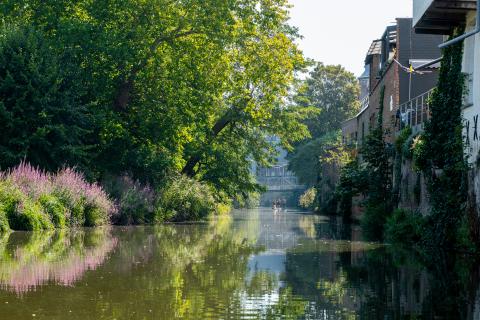 WATSUPS visual
WATSUPS visual
Mechelen
ERDF budget: €4,799,328.00
WATSUPS project aims at mitigating the risk of gentrification by developing a new public space alongside the river Dyle in the city of Mechelen. A visible blue-green corridor will connect people, water and nature. The city chooses to preserve water in the urban landscape, assuring access to all citizens rather than privatizing urban water. They will establish a permanent outdoor swimming area, create river terraces and lowered riverbanks around the Dyle, connect the fragmented walking and cycling zones and develop brand new public parks and park lanes for recreation and social cohesion. The multi-species approach will be strengthened by augmented and virtual reality. Using New European Bahaus principles, the innovative solution will raise awareness on water ecosystems and biodiversity and will strengthen the ecosystem by new technologies and nature-based solutions.
Partnership: City of Mechelen; 2 Infrastructure and (public) service providers: Flemish Water Ways, Flemish Environmental Society; 1 Higher education and research organisation: Thomas More University of Applied Sciences; 1 NGOs: Mechelen Cultural Events ngo; 3 transfer cities – to be selected
 Roma visual
Roma visual
Municipio Roma 3 - Montesacro (MUA)
ERDF budget: €4,980,342.40
We-Z tests a transitional model of urban regeneration to improve mental health in young people. The experimental site is a ‘70s public housing complex called Vigne Nuove located in the North-Eastern periphery of Rome, remained largely unfinished, and today characterised by a diffuse sense of neglect and isolation. The We-Z project will experiment an innovative de-medicalized approach to urban regeneration through the activation of collective imaginations and co-creation activities. We-Z will re-activate affective bonds between people and places and build an attractive district, based on transitional spaces and objects to trigger the active and self-reflective engagement of young people.
Partnership: District III of Rome – Montesacro; 1 Higher education and research organisation: Department of Architecture, Roma Tre University; 3 Sectoral agencies: LOCAL HEALTHCARE ENTERPRISE ROMA1, ATER - Agenzia Territoriale Edilizia Residenziale, Soprintendenza Speciale Archeologia Belle Arti e Paesaggio di Roma (SSABAP); 4 SME: Officine Zero, Future Ecologies, Avanzi. Sostenibilità per Azioni S.p.A. SB, Solidarius Italy s.e.; 2 Others: Parsec Agri Cultura company Agricultural social cooperative, PARSEC SOCIAL COOPERATIVE; 1 NGOs: Artestudio; 3 transfer cities – to be selected
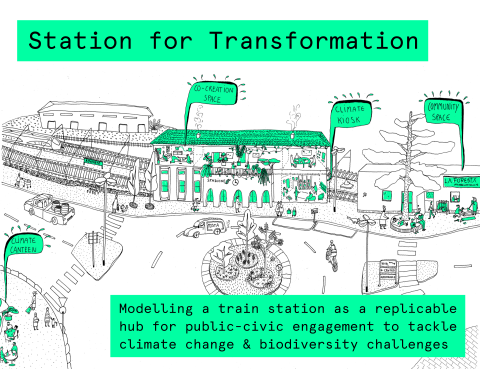 S4T visual
S4T visual
Comune di Rovereto
ERDF budget: €4,997,697.50
The alpine town of Rovereto needs to improve the quality of life of its citizens by regenerating and transforming the cultural heritage of the territory in face of mounting climate and biodiversity challenges. Therefore, the city proposes to transform the empty main building of the train station and its surrounding area into a public-civic hub whose spaces will serve as interactive venues for training, co-design, co-production and knowledge transfer for promising public, civic and economic initiatives on to tackle climate change, biodiversity loss and heritage regeneration. The implementation of the S4T solution mobilizes NEB’s three core values and principles of “Understand, Adapt and Use”.
Partnership: Municipality of Rovereto (COR); 1 local public authority: Community of the Lagarina valley (LAG); 3 NGOs: La Foresta- Community academy (FOR), Europe Consulting (EUC), International Cooperation Centre (CCI); 2 Higher education and research organisations: University of Trento (UTN), COFAC - Cooperativa de Formação e Animação Cultural C.R.L. (COF); 2 SME: Campomarzio social cooperative (CAM), Trentino Social Tank cooperative society (TST); 3 transfer cities – to be selected
Tallinna linn
ERDF budget: €4,999,248.00
The SOFTacademy project seeks to accelerate neighbourhood level circular renovation of large multi-owner apartment buildings with a hardware and software approach demonstrating how residents’ initiatives in renovation boosts re-design of the whole neighbourhood, including spaces in between buildings. The project will develop a collaborative innovation model for urban governments to accelerate private renovation by improving overall urban liveability, creating better micro-climate, increasing biodiversity, accommodating community functions, changing the scale of buildings and creating “cozier” and more human scale living environment. The intervention logic as well as digital tools developed as a part of the solution are transferable to any mass-produced mono-functional apartment building districts that needs a change that goes beyond just renovation and is able to give a sense of place and identity.
Partnership: Tallinn city; 1 Higher education and research organisation: Tallinn University of Technology; 6 NGOs: M TÜ Living Street, Estonian Union of Co-operative Housing Associations, Housing Assosiation Akadeemia tee 4, Housing Association Akadeemia tee 6, Housing Assosiation Akadeemia tee 14, Housing Assosiation Akadeemia tee 22; 3 SME: Yoko Oma OÜ, LAB Verte, Think Softer Planning AB.
Turun kaupunki
ERDF budget: €3,898,963.36
The city of Turku has an ambition to become one of the world’s leading nature and climate cities. Therefore, Turku Biodiversity Action Plan seeks to protect and restore biodiversity in urban areas where habitats are lost due to rapid urbanization, through innovative solutions. Following New European Bahaus principles, Urban Biodiversity Parks project will develop an innovative concept of urban biodiversity park as a tool to establish a platform for developing and testing experimental approaches, for preserving and actively enhancing biodiversity in urban environment. This project will involve different groups such as local inhabitants, NGOs, education institutions and private actors, to increase stakeholders’ awareness and capacity for biodiversity conservation.
Partnership: City of Turku; 3 Higher education and research organisations: University of Turku, Turku University of Applied Sciences Ltd, Natural Resources Institute Finland; 1 Regional Public Authority: Valonia Regional Council of Southwest Finland; 1 NGOs: Wild Zone; 1 Enterprise: Vaso Ltd; 1 SME: Blokgarden Oy; 3 transfer cities – to be selected
Grad Varaždin
ERDF budget: €4,133,140.48
The Agglomeration of Varaždin and Ludberg, located in the north Croatia, have a high strategic interest: the River Drava Forest Park. However, this Drava Park faces three main challenges: management difficulties, unused public spaces and forest degradation. Therefore, the InterAct Green project aims to create a Green Infrastructure Platform that will serve to answer the interdisciplinary management issues, to ensure a proper functioning of it while securing usable information for visitors to the park. This platform will serve as a tool in decision making and communication between all stakeholders. By doing so, the proposed physical infrastructure investments together with the long-term forest regeneration plan for the ecosystem in the area will result in high quality, inclusive and safe-public space.
Partnership: The City of Varaždin; 1 local public authority: The City of Ludbreg (CL); 2 Higher education and research organisations: Faculty of Organization and Informatics, University of Zagreb (FOI), Croatian Forest Research Institute (CFRI); 1 Regional public authority: Public institution 'Nature of Varaždin County' (PINVC); 1 sectoral agency: Varaždin Tourist board (VTB); 3 transfer cities – to be selected
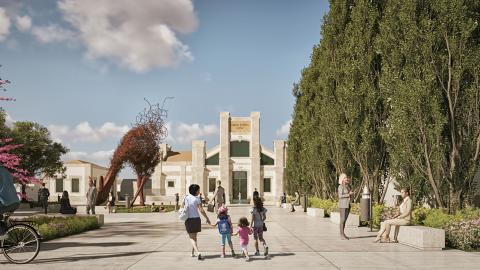 Viana de Castelo visual
Viana de Castelo visual
Município de Viana do Castelo
ERDF budget: €4,994,857.60
The Municipality of Viana de Castelo aims to increase city’s attractiveness towards young talents by triggering its blue innovation potential. The project will deliver a creative and community lab operating in the spirit of Science+Technology+ARTS and potentiating art-driven blue innovation, to co-create unconventional solutions and revitalise the surrounding poor neighbourhood. To host this Centre, the project will transform the municipal old slaughterhouse building, demonstrating a set of innovative energy-efficiency, low carbon and circular solutions and using New European Bauhaus principles. The retrofitted and amplified building will be a fusion of innovative components (including experimental technologies currently available in prototype version) that have never been brought together in one single establishment, which will be tested in a real environment. This includes the use of experimental practices involving natural local residues as construction materials, a novel system for storing surplus electrical renewable energy of the building in the form of green hydrogen and turning this back into electricity when there is deficit of production, as well as the first building to integrate a digitally controllable rotating pilot division to maximise solar energy harvest. Viana S+T+ARTS Centre project will provide novel sustainability solutions and contribute to environmentally responsible behaviour in the community.
Partnership: Viana do Castelo Municipality; 1 NGOs: Deão Youth Association; 1 Other: Institute for Research and Tech Development in Construction, Energy, Environment and Sustainability; 2 SME: INOVA+, INNOVATION SERVICES S.A., DINAMO10; 1 Business support organisation: Business Association of Viana do Castelo; 1 Higher education and research organisation: Polytechnic Institute of Viana do Castelo; 3 transfer cities – to be selected